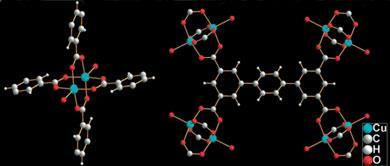A new material that absorbs significant amounts of hydrogen has been reported by UK chemists.
A new material that absorbs significant amounts of hydrogen has been reported by UK chemists.
Safe, efficient storage of hydrogen gas is one of the key technological hurdles in the quest to develop vehicles that can be powered by hydrogen fuel cells. The US Department of Energy (DOE) has set a storage target for such materials that requires them to hold at least 6.5 per cent of their own weight in hydrogen gas. But developing these materials before the DOE’s deadline of 2010 is proving to be a tremendous challenge for materials scientists.
There are many different types of candidate materials that are capable of storing hydrogen molecules, and one of the most promising is a class of substances known as coordination frameworks: three-dimensional crystalline networks held together by multiple bonds between charged metal ions and carbon-based ligands.
Neil Champness of the University of Nottingham, UK, and his colleagues have now developed a coordination framework material that is the best yet in terms of hydrogen storage. ’It’s very close to the US Department of Energy target,’ he told Chemistry World.

The team’s framework materials combined copper with molecular chains of benzene rings, each carrying four carboxylic acid groups. At pressures of 20 bar, the materials could store up to 6.07 per cent by weight of hydrogen.
Champness says they are comparable to porous inorganic materials called zeolites that can trap hydrogen gas inside their pores. But tailoring the precise properties of the coordination framework is much easier, because the size and nature of the pores is dependant on the size and chemical characteristics of the ligands. This means that relatively simple organic chemistry can be used to control the materials’ properties. ’In principle we can tune the interior and tailor it to whatever hydrogen needs,’ said Champness. Their calculations show that it should be possible to increase their materials’ hydrogen capacity even further.
However, the materials currently require low temperatures to achieve the high loading of hydrogen. This would limit their practicality in vehicles, so his team are working to improve this aspect of their materials. He said they are also studying how fast hydrogen can be loaded into and released from the materials.
Tom Westgate
Storing up high hopes for hydrogen economy
Polymer scientists have joined the race to store hydrogen as fuel.
Cars that run on hydrogen still fail to compete in real terms with traditional petrol vehicles. Maciej Gutowski and Tom Autrey investigate the advances in hydrogen storage material...
References
Angew. Chem. Intl. Ed., 2006, doi: 10.1002/anie.200601991






No comments yet